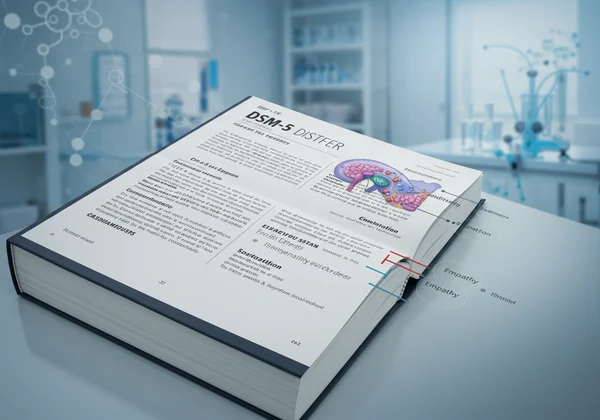Am I A Narcissist? Take Our Free Test
We often toss around terms like "narcissist" to describe someone obsessed with themselves or social media. But beneath the surface, Narcissistic Personality Disorder (NPD) is a far more intricate psychological condition, not just a label for self-centeredness. This guide will explore what NPD truly is, its official diagnostic criteria, the different ways it can manifest, and its key characteristics, providing the clarity needed for a deeper, more empathetic understanding.
The journey to understanding can begin with a single step. If you're questioning certain behaviors in yourself or someone else, gaining initial insights is crucial. A confidential npd screening tool can be a valuable starting point for self-reflection.
Comprehensive Guide to Narcissistic Personality Disorder (NPD)

At its core, Narcissistic Personality Disorder is a mental health condition characterized by a deep-seated pattern of grandiosity, a constant need for admiration, and a lack of empathy for others. This pattern of behavior is not a choice but a complex personality structure that significantly impacts a person's relationships, work, and overall sense of self. It creates a fragile self-esteem that is highly dependent on external validation.
This condition is more than just having high self-confidence. While confidence is generally rooted in real achievements and a stable sense of self-worth, the grandiosity seen in NPD is often a facade. It masks deep-seated feelings of insecurity, shame, and vulnerability. Grasping this difference is crucial; it helps us approach the disorder with more understanding and less judgment.
Defining NPD: More Than Just Self-Absorption
While self-absorption is a component of NPD, the disorder is far more intricate. It involves a skewed self-image where individuals feel they are uniquely superior, special, or entitled. They often believe they deserve the best of everything and can become upset or angry when they don't receive the attention or special treatment they feel they are owed.
This internal dynamic often leads to manipulative or exploitative behavior in relationships. Because of their difficulty with empathy, individuals with narcissistic traits may not recognize or identify with the feelings and needs of others. Their primary focus remains on their own needs and desires, which can cause significant distress to those around them. For those wondering about their own tendencies, a free npd test can offer a private way to explore these patterns.
The DSM-5 TR Criteria for NPD Diagnosis
To ensure a standardized and reliable understanding, mental health professionals use the Diagnostic and Statistical Manual of Mental Disorders, Fifth Edition, Text Revision (DSM-5-TR). This is the authoritative guide that outlines the specific criteria for diagnosing personality disorders, including NPD. Our own dsm5 npd test is based on these clinical standards.

According to the DSM-5-TR, a diagnosis of NPD requires a pervasive pattern of grandiosity, need for admiration, and lack of empathy, indicated by five (or more) of the following nine criteria:
- A grandiose sense of self-importance.
- A preoccupation with fantasies of unlimited success, power, brilliance, beauty, or ideal love.
- A belief that they are "special" and unique and can only be understood by, or should associate with, other special or high-status people.
- A need for excessive admiration.
- A sense of entitlement.
- Interpersonally exploitative behavior.
- A lack of empathy; is unwilling to recognize or identify with the feelings and needs of others.
- Envy of others or a belief that others are envious of them.
- Arrogant, haughty behaviors or attitudes.
Exploring the Different Types of Narcissism
Narcissism is not a one-size-fits-all label. The disorder can present in several different ways, which is why recognizing it can sometimes be challenging. Understanding these variations helps create a more nuanced picture of the condition, offering deeper insight into specific behavioral patterns.
The most widely recognized subtypes are grandiose and vulnerable narcissism, but other expressions also exist. Each type shares the core traits of entitlement and a lack of empathy but differs in how these traits are expressed externally.
Grandiose vs. Vulnerable Narcissism: Key Distinctions

The distinction between grandiose and vulnerable narcissism is perhaps the most critical for understanding the spectrum of NPD. Grandiose narcissism is the more stereotypical version, characterized by extroversion, dominance, and an overt sense of superiority. These individuals are often charming, confident, and assertive, openly seeking admiration and power. They may appear successful and in control, but their relationships often suffer due to their entitlement and arrogance.
Vulnerable narcissism, on the other hand, is more hidden. These individuals still possess a deep-seated sense of entitlement and grandiosity, but it is masked by insecurity, defensiveness, and hypersensitivity to criticism. They may appear shy, anxious, or even depressed. Their narcissistic needs are expressed more passively, often through victimhood or passive-aggression, making it harder to spot.
Other Expressions: Communal & Malignant Narcissism
Beyond the main two types, other forms of narcissism have been identified. Communal narcissism describes individuals who derive their sense of grandiosity from being perceived as the most helpful, caring, or altruistic person in their community. They may publicly dedicate themselves to noble causes, but their underlying motivation is still the pursuit of admiration and validation, not genuine empathy.
Malignant narcissism is a more severe and dangerous form. It combines the core traits of NPD with antisocial behavior, paranoia, and aggression. This type is not a formal diagnosis in the DSM-5-TR but is a clinical concept used to describe individuals who are not only narcissistic but also take pleasure in the suffering of others.
Recognizing the Signs of Narcissism
Identifying the signs of narcissism is crucial for self-doubting explorers and concerned family members alike. Recognizing these patterns is the first step toward understanding the challenges at play and deciding on the best course of action, whether it's seeking therapy or setting healthier boundaries in a relationship. If you are questioning your interactions, you might consider how to test for narcissism through a preliminary screening.
Core Characteristics and Behavioral Patterns of NPD
The behavioral patterns of NPD revolve around maintaining a grandiose self-image at all costs. This often includes a sense of entitlement, where the person genuinely believes they deserve special treatment and priority. They may react with surprise or rage when their expectations are not met.
Another core characteristic is a profound lack of empathy. This isn't necessarily an inability to understand emotions intellectually but a disconnect from feeling them for others. This can lead to manipulation and exploitation, as they may use others as tools to achieve their own goals without guilt. Constant need for admiration, arrogance, and a tendency to devalue others to feel superior are also common behavioral markers.
Common Myths About Narcissism Debunked
Several myths about narcissism can hinder true understanding. One common myth is that all narcissists are loud, successful, and overtly arrogant. As we've seen with vulnerable narcissism, this is not true. Many individuals with NPD suffer quietly, consumed by feelings of inadequacy and shame.
Another myth is that narcissism is just extreme selfishness. While selfishness is a component, NPD is a clinical disorder with deep roots in early life experiences, genetics, and neurobiology. It's not simply a bad attitude or a moral failing. Dispelling these myths is essential for an informed and responsible conversation about the topic.
Your Journey to Understanding NPD and Next Steps
Whether you're exploring your own tendencies or seeking to understand someone close to you, the journey through Narcissistic Personality Disorder's complexities can feel daunting. This guide has offered a comprehensive overview, laying the groundwork for clarity and empowerment. Remember, true insight often begins with personal reflection. If this information resonated with you, consider taking our confidential NPD test. It's a private, judgment-free way to explore these traits and can be a meaningful first step towards professional guidance if you need it.

Frequently Asked Questions About NPD
What is an NPD test?
An NPD test is typically a screening questionnaire designed to identify traits associated with Narcissistic Personality Disorder. A good online tool, like the one offered on our site, is based on the clinical criteria found in the DSM-5-TR. It is not a formal diagnosis but a confidential and accessible way to gain preliminary insights into your own behavioral patterns.
How common is Narcissistic Personality Disorder?
Estimates suggest that NPD affects up to 6% of the population, though the actual number may be higher as many individuals with the disorder do not seek treatment. It appears to be more commonly diagnosed in men than in women.
Do narcissists know they're narcissists?
This is a complex question. Some individuals with NPD, particularly those with more insight or who have been in therapy, may become aware of their diagnosis and patterns. However, many lack the self-awareness to recognize their behavior as problematic. Admitting to having NPD would contradict their grandiose self-image, making self-recognition difficult. If you are asking, "How do I check if I have NPD?", taking a confidential NPD test can be a private first step.
Can Narcissistic Personality Disorder be cured or treated?
While there is no "cure" for personality disorders, long-term psychotherapy can help individuals manage their symptoms, develop healthier coping mechanisms, and improve their relationships. Treatment can help them build genuine self-esteem and learn empathy. The journey is challenging but change is possible with commitment and the right professional support.